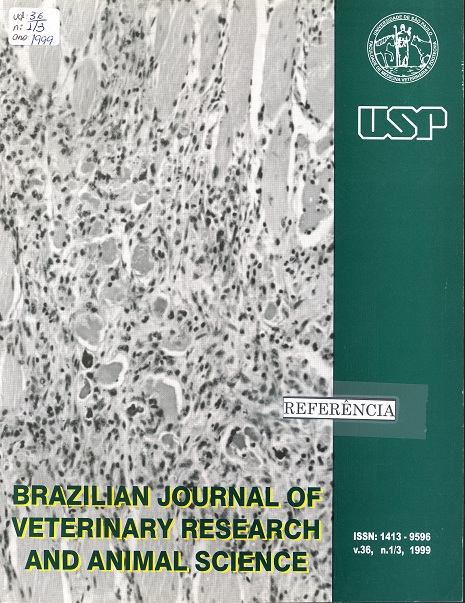Occurrence of protozoa and helminths in faecal samples of dogs and cats from São Paulo city
DOI:
https://doi.org/10.1590/S1413-95961999000200006Keywords:
Dogs, Cats, Helminthes, ProtozoaAbstract
Faeces from 353 dogs and 187 cats, received from January 1991 to January 1995 in the Department of Preventive Veterinary Medicine and Animal Health, Faculty of Veterinary Medicine, University of São Paulo, were examined for the presence of parasites. The animals were from different areas of the city of São Paulo, and the faecal materials were examined by the methods of flotation in sucrose solution and centrifuge-sedimentation in water-ether. Approximately 45.0% of the dog samples (160 samples) were positive and the occurrence (%) of parasites, in relation to the total of samples was: Ancylostoma spp. 20.40; Toxocara canis 8.49; Giardia sp. 7.65; Cryptosporidium parvum 2.83; Cystoisospora spp. 2.55; Sarcocystis spp. 1.70; Hammondia heydorni 0.85; and Spirocerca lupi, Trichuris vulpis and Dipylidium caninum 0.28. From the 187 cats samples, only eight were negatives and the occurrence (%) was: Cystoisospora spp. 38.5; Toxocara sp. 34.22; Giardia sp. 16.04; Cryptosporidium parvum 14.44; Ancylostoma spp. 13.37; Dipylidium caninum 10.69; Sarcocystis spp. 8.56; Physaloptera spp. 4.81; "Hammondia-Toxoplasma" 1.60; Strongyloides stercoralis 1.60; and Platynosomum concinum 1.07. In dogs, the most frequently associations were: Ancylostoma spp. + T. canis in eight samples and Ancylostoma spp. + Giardia sp. and Ancylostoma spp. + T. vulpis in five samples for each one of the associations. In cats, Toxocara sp. + Cystoisospora spp. were present in 24 samples, and Toxocara sp. + Ancylostoma spp. in five samples.Downloads
Download data is not yet available.
Downloads
Published
1999-01-01
Issue
Section
VETERINARY MEDICINE
License
The journal content is authorized under the Creative Commons BY-NC-SA license (summary of the license: https://
How to Cite
1.
Gennari SM, kasai N, Pena HF de J, Cortez A. Occurrence of protozoa and helminths in faecal samples of dogs and cats from São Paulo city. Braz. J. Vet. Res. Anim. Sci. [Internet]. 1999 Jan. 1 [cited 2026 Jan. 7];36(2):87-91. Available from: https://revistas.usp.br/bjvras/article/view/5767





